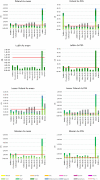Dietary exposure to potentially harmful elements in edible plants in Poland and the health risk dynamics related to their geochemical differentiation
- PMID: 37231099
- PMCID: PMC10212926
- DOI: 10.1038/s41598-023-35647-x
Dietary exposure to potentially harmful elements in edible plants in Poland and the health risk dynamics related to their geochemical differentiation
Abstract
Differences in the health risk values calculated for consumers of potentially harmful elements (PHEs) present in edible plants were investigated. Based on a comprehensive literature search, the highest PHE contents in plants were identified in the southern and western regions of Poland, that also revealed the highest geochemical enrichment with Zn, Pb, Cu, As, Cd, and Tl. The highest unacceptable non-carcinogenic risk (HQ) values for mean PHE contents in Poland were found for Pb: toddlers (2.80), pre-schoolers (1.80), and school-aged children (1.45) and for Cd for toddlers (1.42). The highest unacceptable carcinogenic risk (CR) values for mean As content was observed for adults (5.9 × 10-5). The highest non-carcinogenic risk values for consumers were reported in Silesia, Lower Silesia, Lublin, Lesser Poland, and Opole Provinces, indicating the impact of geochemical variability on risk values.
© 2023. The Author(s).
Conflict of interest statement
The authors declare no competing interests.
Figures





References
-
- Day L. Proteins from land plants—potential resources for human nutrition and food security. Trends Food Sci. Technol. 2013;32:25–42. doi: 10.1016/j.tifs.2013.05.005. - DOI
-
- WHO. Healthy diet. WHO Newsroom.https://www.who.int/news-room/fact-sheets/detail/healthy-diet (2020).
-
- Harvard University. Healthy Eating Plate. Harvard T.H. Chan School of Public Health.https://www.hsph.harvard.edu/nutritionsource/healthy-eating-plate/ (2017).
-
- Wolnicka, K. Talerz zdrowego żywienia. Narodowe Centrum Edukacji Żywieniowej.https://ncez.pzh.gov.pl/abc-zywienia/talerz-zdrowego-zywienia/ (2020).
-
- Yahia, E. M. Contribution of fruits and vegetables to human nutrition and health. In Postharvest Physiology and Biochemistry of Fruits and Vegetables (ed. Yahia, E. M.) 19–45 (Woodhead Publishing, 2019).
Publication types
MeSH terms
Substances
LinkOut - more resources
Full Text Sources
Research Materials

